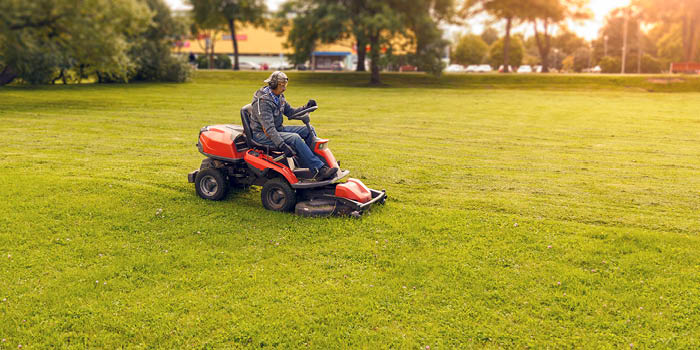- Home
- Loss Control
- Loss Control Insights
- A practical guide to lawn mower safety in school settings
Maintaining a school’s grounds is no small task—and for many maintenance teams, that includes regular use of lawn mowers. These machines may seem routine, but they’re powerful equipment that requires proper training, care, and caution. Practicing lawn mower safety is essential to protect school staff and ensure smooth, injury-free operations.
Why lawn mower safety matters
Each year, thousands of injuries occur due to improper mower use. According to the U.S. Consumer Product Safety Commission, more than 80,000 people are treated in the ER each year due to lawn mower-related injuries—many involving lacerations, burns, and rollovers.
In a school setting, these risks can increase due to:
- Tight mowing schedules
- Large, varied landscapes
- Limited staff training
- Shared equipment between team members
That’s why it’s critical for schools to have clear procedures, proper training, and consistent use of lawn mower
safety tips.
Tip for school grounds crews
Here are simple but important ways to reduce risk when operating school mowing equipment:
1. Start with the right training
Every mower is different. Staff should be trained on the specific make and model they’ll be using. This includes starting and stopping procedures, proper turning, adjusting blades, and recognizing hazards. Training should be refreshed annually.
2. Dress for the job
Personal protective equipment (PPE) is a must. At a minimum, operators should wear:
- Safety glasses or goggles
- Hearing protection
- Long pants and closed-toe shoes (preferably steel-toe)
- Gloves, if recommended by the equipment manufacturer
3. Do a walkthrough before mowing
Before starting any job, walk around the area and remove potential hazards—sticks, rocks, toys, or debris—that could turn into dangerous projectiles.
4. Skip reverse
Most injuries involving bystanders happen when mowing in reverse. Always mow forward and be aware of who’s nearby, especially during school hours or in shared-use spaces like athletic fields.
5. Keep blades sharp and equipment maintained
Dull blades increase strain on the machine and make mowing less predictable. Routine maintenance can also catch issues like oil leaks or loose parts that might cause breakdowns or injuries.
Make it stick with the right training and resources
If you’re responsible for a school’s mowing operations or equipment, it’s worth investing in regular, documented training for your team. Helpful resources include:
- OSHA's landscaping safety guidelines
- Manufacturer safety manuals and online video tutorials
- State or local safety councils, which often offer workshops or materials tailored to groundskeeping
- Internal safety checklists and job hazard analyses for consistent protocols
Many insurance partners—like EMC—also offer access to safety materials and on-demand training to support lawn mower safety efforts on campus.
Keep people clear
Even with experienced operators, safety isn’t just about who’s driving the mower. Schools should establish boundaries to prevent foot traffic near mowing zones and communicate with staff when mowing is in progress. Consider signage or cones during high-traffic times.
Lawn mower safety starts before the engine does
Following these lawn mower safety tips and offering consistent training isn’t just good practice—it’s how schools protect their people and keep things running smoothly. A few extra minutes of prep can help prevent serious injuries and reduce downtime.
Get in touch
Need help? We’re here for you! Whether you have questions or need personalized assistance, your local office is ready to support you.
Loss Control Insights
Stay informed with the latest news and receive actionable safety tips, all carefully curated by our team of experts.
